In July 2024, an historic letter, penned by famed Potawatomi leader Simon Pokagon in 1898, was donated to the Chicago History Museum by trustee John Low. Low is an author, historian, and professor at The Ohio State University, and a member of the Pokagon Band of the Potawatomi. He has written extensive articles and books on Potawatomi history and has worked to preserve ancient Indian effigy mound burial areas in Ohio and the Midwest.
Low purchased the letter from an online auction after being alerted by his friend and fellow tribe member Mike Winchester.
“It is not often that you find an historic source-document like this come for sale,” Low notes. “This letter was hand-written by Simon Pokagon and helps shed light on his authorship of a book by Pokagon printed shortly after his death.”
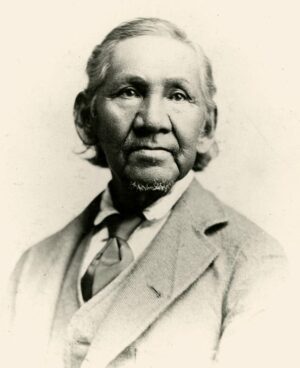
Portrait of Simon Pokagon, The City Beyond the White City: Simon Pokagon and The Red Man’s Rebuke/the Red Man’s Greeting. Public domain.
Simon Pokagon (1830–99) was a lifelong advocate for repatriation of traditional Indian lands, even meeting with President Abraham Lincoln to plead the Potawatomi’s case. Simon’s father, Chief Leopold Pokagon (1775–1841), attended the 1833 Treaty of Chicago and negotiated favorable concessions for his people that ultimately saved them from being evicted from their southwest Michigan lands. In 1838, the federal government removed 850 Potawatomi members from their northern Indiana homes in what became known as the Potawatomi Trail of Death—a forced march from Indiana to Kansas that resulted in the deaths of 40 people on the 660-mile, two-month journey. Due to Leopold’s astute negotiations, the Pokagon Potawatomi group was spared from the march and allowed to remain in Michigan. Leopold then successfully petitioned the Michigan Supreme Court to allow his people to stay on land that he had purchased.
In 1893, Simon Pokagon published The Red Man’s Rebuke, a pamphlet in protest of the World’s Columbian Exposition. In it, he pointed out the violent and unjust treatment of Native Americans and declared that American Indians could not celebrate the world’s fair anniversary of Christopher Columbus, whose arrival destroyed their way of life. Printed on birch bark pages and tied together into a book, The Red Man’s Rebuke was a bold statement that challenged US colonialism.
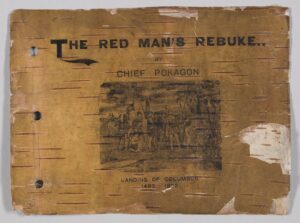
Cover of The Red Man’s Rebuke by Chief Simon Pokagon, printed on birch bark sheet. Published by C.H. Engle, Hartford, Michigan, 1893. CHM, ICHi-065246
In it, Pokagon writes:
In behalf of my people, the American Indians, I hereby declare to you, the pale-faced race that has usurped our lands and homes, that we have no spirit to celebrate with you the Great Columbian Fair now being held in this Chicago city, the wonder of the world. No; sooner would we hold high joy-day over the graves of our departed fathers, than to celebrate our own funeral, the discovery of America. And while you who are strangers, and you who live here, bring the offerings of the handiwork of your own lands, and your hearts in admiration rejoice over the beauty and grandeur of this young republic, and you say, “Behold the wonders wrought by our children in this foreign land,” do not forget that this success has been at the sacrifice of our homes and a once happy race.
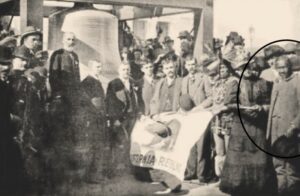
Simon Pokagon (far right) on “Chicago Day” at the World’s Columbian Exposition, Chicago, October 9, 1893. Photograph (c) 2015 by John Low, image used with permission of the owner.
Pokagon went on to speak at the World’s Columbian Exposition on “Chicago Day” to an audience of 75,000 people. His speech was more conciliatory than The Red Man’s Rebuke—calling for all races to assimilate and work together toward common aims. In an act of goodwill, he presented a ceremonial “Deed to Chicago” at the fair. His approach, however, was criticized by some Potawatomi tribal members and others who questioned his authority to do so.
Simon Pokagon died in 1899, and his final book, O-gi-waw-kwe Mit-i-gwa-ki (Queen of the Woods), was published months after his death. The romantic novel tells the story of Pokagon’s wife, Lodinaw, and earned Pokagon the title the “Red Man’s Longfellow” by literary fans. However, many critics, including some in his own tribe, questioned whether the book was ghostwritten by Sarah Engle, the wife of Pokagon’s publisher/attorney.
Low believes the Simon Pokagon letter, written in 1898, provides clues to the true authorship of the book. In it, Pokagon writes about completing Queen of the Woods, proof that he was writing the book one year before its publication. In addition, he uses Potawatomi and Ojibwe/Odawa words in his letter, much like the writing style in his known books and publications.
In an article penned for the Historical Society of Michigan, Low suggests the letter confirms Pokagon’s writing abilities that make him the likely true author of Queen of the Woods. “The substantial length of the letter,” Low notes, “shows the writer to be very literate and capable of the writings ascribed to him.”

CHM trustee John Low presents the Simon Pokagon letter to Julie Wroblewski, former CHM director of collections. Photograph by Eric Miller, July 19, 2024.
Julie Wroblewski, former Chicago History Museum director of collections, agrees with Low’s theory. “Although this letter was written in 1898, it’s as if Chief Pokagon is speaking to us today,” Wroblewski adds. “It’s a simple letter to Pokagon’s friend that also shows the work of an accomplished writer.”
“This letter adds significant depth and context to the Simon Pokagon material at the Museum, including an original copy of Red Man’s Rebuke,” Wroblewski points out. “We are honored to add this important document to our collection to ensure it will be preserved and available for public access to future scholars and researchers.”
The letter is a response to a request for a subscription to a forthcoming magazine called The Coming Age. Pokagon wishes his friend good luck with the new venture, noting that he “can not at present subscribe” and that he is working on writing his book, Queen of the Woods. He then goes on to recommend three friends who could be contacted to ask for a subscription.
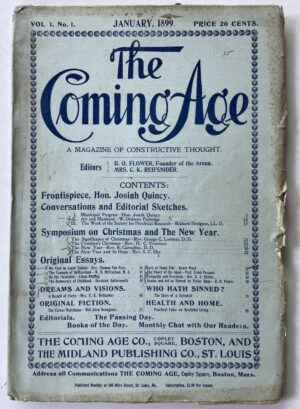
The Coming Age: A Magazine of Constructive Thought, vol. 1, no 1. January 1899. Image courtesy of Eric Miller, 2024.
The first issue of The Coming Age: A Magazine of Constructive Thought was printed in January 1899, less than two months after Pokagon’s letter. The magazine’s founder and editor, author B. O. (Benjamin Orange) Flower, is likely the recipient of Pokagon’s letter. Pokagon closes his letter with a blessing to his friend written in both English and Potawatomi and Ojibwe/Odawa. The vivid writing style is similar in style to the text in his many books and publications.
The text of the letter reads:
Hartford Mich Oct 26 1898
Editor of Coming (sic) age My Dear Friend and Brother
Your circular at hand. Am indeed glad to know you have started out on a different venture, but still are the secure trail-founding away for better days, at the door of tyrannical customs, fashions & all that holds the deserving in bonds of poverty & his grace – I regret I can not at the present subscribe for the “Coming age” – But the fact is ‒ over
I am striving every move to publish “Queen of the Woods” a book that I long have been desirous to have published
I send you herewith the following names
Mrs Marsella Goodspeed
Mrs Lydia Young
H.M. Alney all of Hartford Mich
I feel like taking you by the hand my dear Brother & say God bless your noble soul. May “Waw-Kwe’ (Heaven) bless “The Coming Age” most abundantly, & hasten the time when when all classes & races shall acknowledge each other as brothers and that Kiji’ man-l-to o-os-si’-maw kaw-ke’-naw (is God the father of all) Sincerely, yours Chief Simon Pokagon
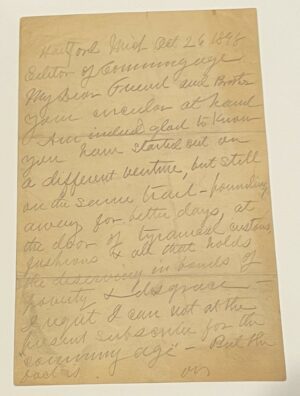
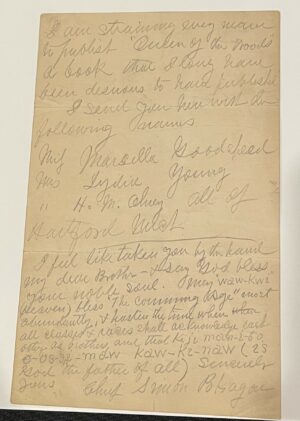
The front and back of the letter written by Simon Pokagon, 1898. Photograph by Eric Miller, 2024.
Read the full press release of Low’s generous donation.
Further Reading
A Brief History of the Pokagon Band
John N. Low, Imprints: The Pokagon Band of Potawatomi Indians and the City of Chicago. (Michigan State University Press, 2016).
John N. Low, “Chicago is on the Lands of the Potawatomi – Why Land Acknowledgments for Chicago Should Acknowledge This Historical Fact,” Chicago History xlvi, no. 2 (Fall/Winter 2022–23): 16–27.
Simon Pokagon, O gi-māw-kwĕ Mit-i-gwā-kî (Queen of the Woods) (1899).




